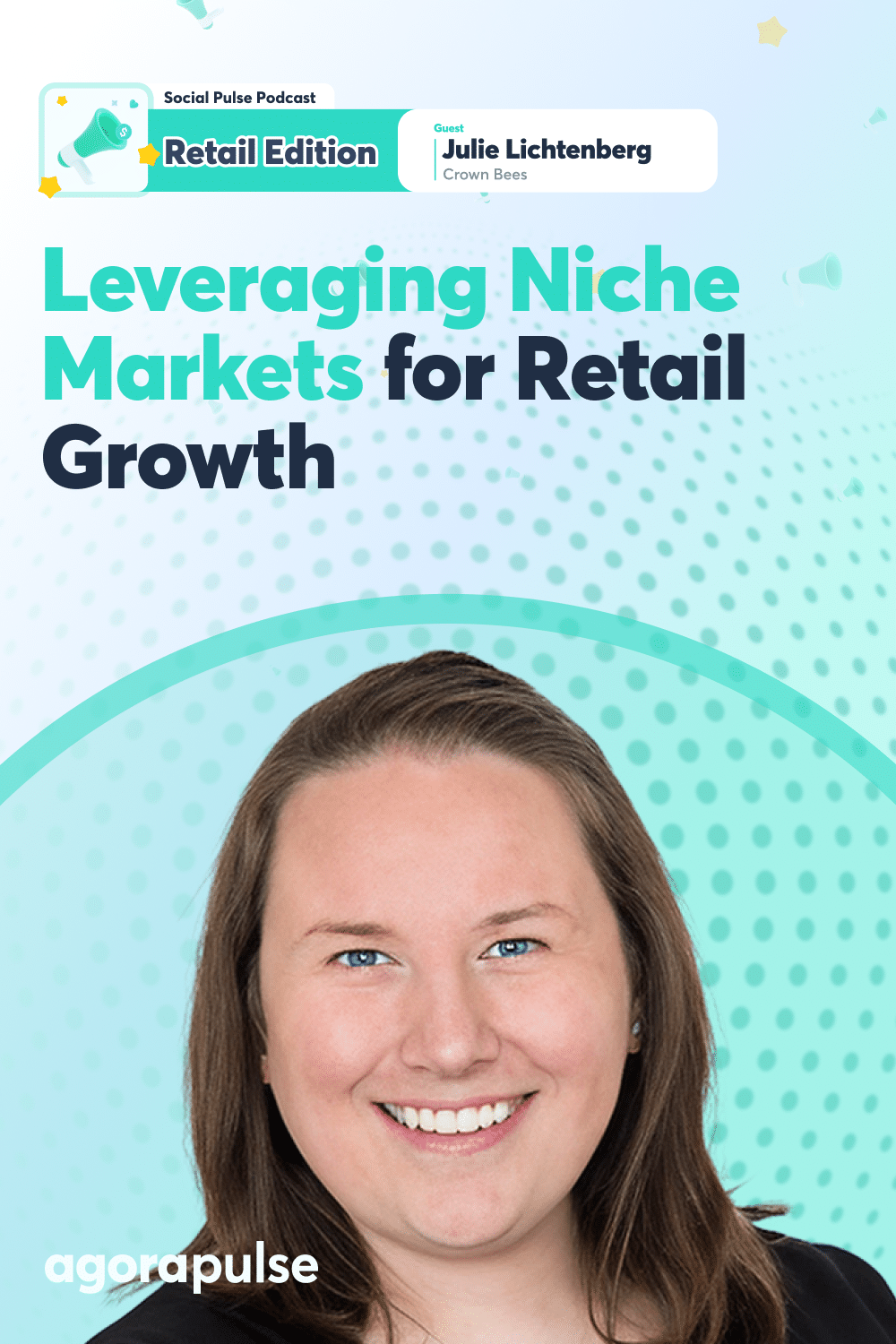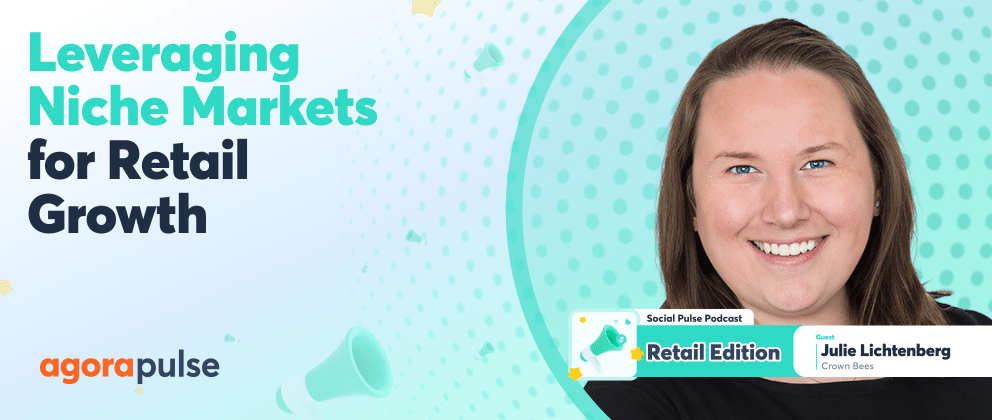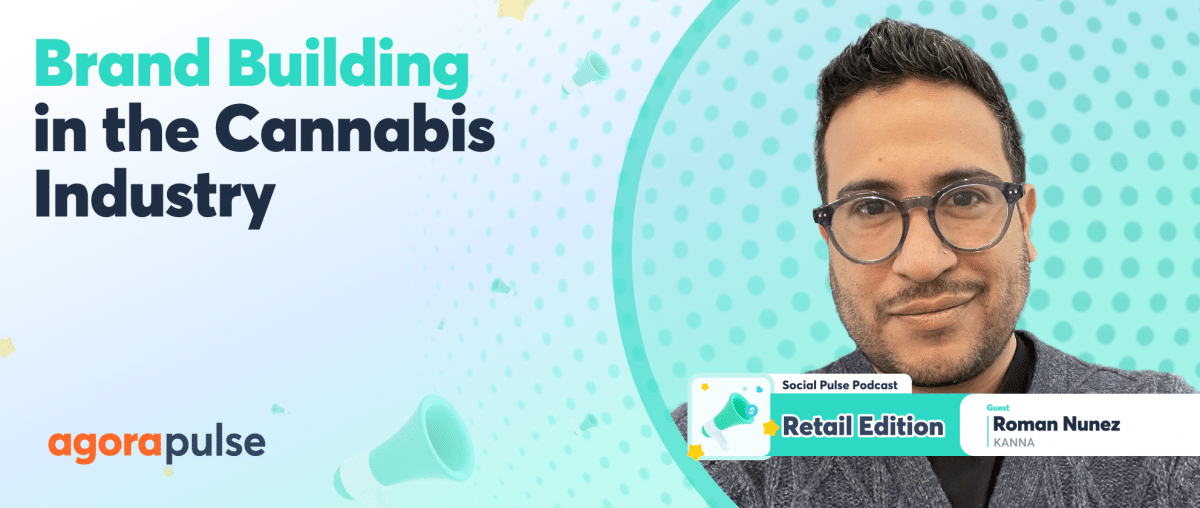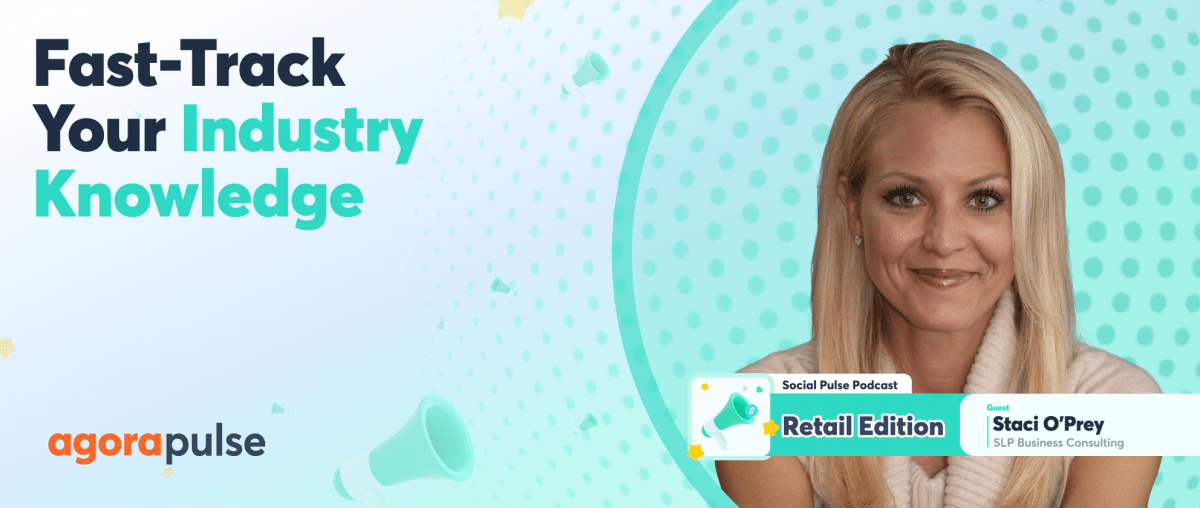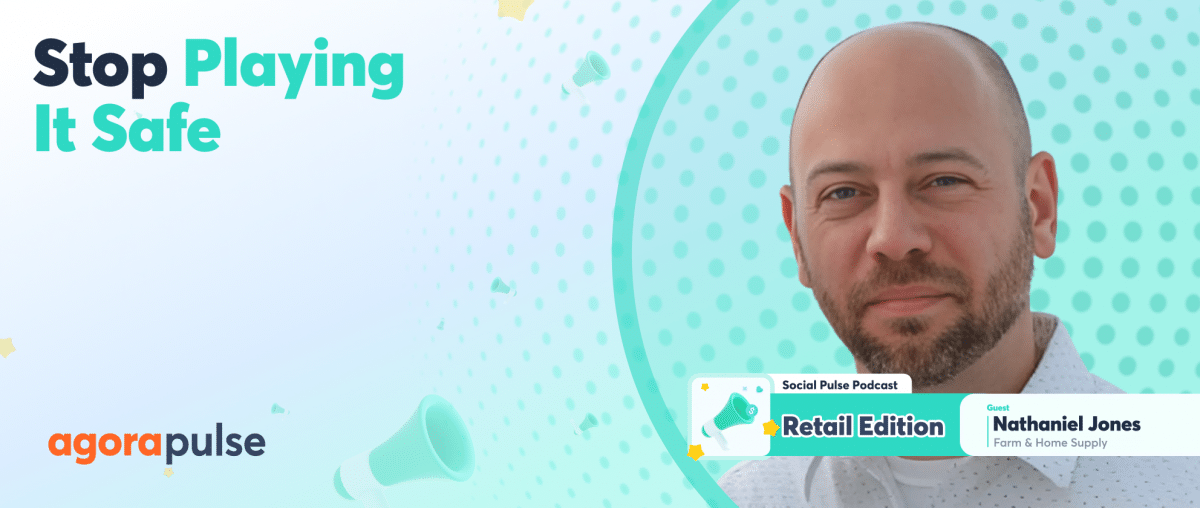Many retail marketers face this problem: You’re trying to be everything to everyone and consequently becoming nothing special to anyone. Your marketing budget stretches thinner each quarter while your engagement metrics barely budge. You watch as smaller, more focused brands seem to create passionate customer communities almost overnight and wonder what they know that you don’t.
That’s what our Social Pulse: Retail Edition episode’s guest specializes in solving. Julie Lichtenberg is a marketing powerhouse who has mastered the art of identifying and connecting with niche audiences in innovative ways that drive real business results. The marketing communications director at Crown Bees talks with host Agorapulse’s Chief Storyteller Mike Allton.
[Listen to the full episode below, or get the highlights of the Social Pulse: Retail Edition, powered by Agorapulse. Try it for free today.]
How did you begin specializing in “identifying unique target audiences” at Crown Bees?
Julie Lichtenberg: My career actually started in retail many years ago in the last century. And I was stuck in retail for quite some time, and after a while, I started thinking about all of these different sales promotions that I have to say to customers. It’d be fun to be on the receiving end of creating those promotions and alerting customers of new things that are happening in the store.
So I was in a lot of retail. I was in a Hollywood Video just to age me a little bit. I was on IMDB before that existed. So, through retail and customer service, I found myself in marketing. When I started in marketing, social media was not a thing yet, we had just done the big migration from MySpace to Facebook as a society and LinkedIn was just starting to be a thing. I grew up in marketing alongside social media. So that’s been very interesting.
And every role I’ve had since then, whether it was a small business or a nonprofit to now e-commerce, social media has always been a part of that. And it has to be. It can sometimes be difficult to explain to the boss why social media is so important throughout my time …
As part of my nonprofit work, I also worked at the Washington State PTA, where everything is authentic. You have to be authentic, you have to be very community-engaging. And here I am now here at Crown Bees, [where] there is a community of beekeepers. And I don’t mean honeybees, we’ll get into that. But it’s been a big part of everything I do and being authentic.
The one thing that I always say is just make sure your posts are human. I know AI is a thing, we’ve adopted AI. However, you still have to look at the post before you post it: Does this sound like a human? Does this sound not just like our brand voice, but does this sound like an actual person? Because most customers can see the difference and that’ll make or break a sale. So, that’s where I am now.
The nineties were 10 years ago. I will die on that hill. Crown Bees [is] such a fascinating company, and I’m so happy to hear. So let me twist it on you. When I say “bees”, what is the first thing you think of?
Mike Allton: I think of honeybees, pollinating, buzzing around outside my children.
Julie Lichtenberg: Yep. Okay. You proved my point. And you’ll see what my point is.
Part of our social media is combating—this is what our owner loves to say—is “combating public ignorance.” And he doesn’t mean that in a bad way. He means because we’ve been trained so much to immediately think of the honeybee and honey.
All bees do not make honey. Only 0.02% of all honeybees or all bees in the world make honey. The rest are solitary bees, and they’re just doing their own thing, and they don’t sting. So part of my job is to educate people through social media as well as newsletters and our website to educate people. These bees are very gentle. You can raise them. They have much more pollination power than a honeybee because a honeybee their whole purpose is to bring things back to the hive. Solitary bees, like mason bees that we specialize in. They’re solitary, so they’re just out for themselves. I was going to bring in a generational joke, but I’m not going to but I’d like to say that mason bees and solitary bees are like Gen X, zillennials. We’re like, “Eh, just leave us alone. We’re cool. Let us do our own thing. Let me just lay in my cocoons, and I’m fine.”

So, it’s many levels of education that we do through social media. The first is educating people that there is more than just the honeybee. And then the next step is once they’re interested in raising these bees, okay, now you’re falling down the rabbit hole.
And how do we make our website help you in that journey? So our customer journey is very interesting because we’re not selling shoes. Do you know what a shoe is?
Bees, on the other hand, fall into a whole thing with pollinators. And native pollinators. Whereas the honey bee came from Europe, Mason Bees, they’re from here. (I could go on and on, but I know we’re here to talk about social media!)
How do you identify target audiences beyond those demographics?
Julie Lichtenberg: Yeah, one of the things definitely is that for a long time, this was a long discussion with our owner. It was older folks who were keeping the bees that were doing the mason bees, and they knew what they were doing. And sometimes there isn’t always that knowledge-sharing.
And so now with the big movement, especially since the pandemic of people wanting to grow their own food. Or I need a new hobby that has opened up a brand new group of folks, specifically millennials. I’m a half millennial, so it’s interesting. But millennials now are going towards those grandparent hobbies and beekeeping is definitely part of that. For us, it was a natural generational change, but we obviously helped with that.
The biggest thing—and you’ll hear this from other folks, too—is meeting your customers where they are. We tried TikTok but it didn’t work for us. Instagram, Facebook work.
Reddit is where we’re finding a lot of community building and knowledge sharing. So I’ve been leaning into Reddit a lot lately as well as YouTube, meeting them where they are.
Are there any specific signals or indicators to help you identify their potential?
Julie Lichtenberg: Honestly, what helps is when people reach out to us, we’re very open. We answer the phone. We do have an AI assistant. However, we do have somebody answering the phone or managing our emails. So, when somebody sends us a question, you’re going to get an answer from one of us. Hearing back directly from customers has been very huge.
Also, just reading comments on our YouTube channel. We have a podcast there, Buzz on Bees, and it’s fascinating because people tell us what they want to know. Or we get an increase in questions, through our customer service. So we lean into what customers know when we do that with our products as well?
Several people have said, “Hey, I need this blah, blah, blah for my bee house because I have this problem.” And then we think about it like, “Let’s fix that because somebody else might be having that problem.” And we do that with social media as well. If a lot of people are asking that, okay, let’s put this house on social media.
A lot of people are asking about carpenter bees. Okay, let’s talk about that.
We had a podcast episode yesterday of the Top Epic Mistakes in Raising Mason Bees. Again, I’ll keep saying it, meeting people where they are really will shorten your customer journey because it takes many more touch points than it used to get people to buy it because we’re in such a niche industry, it’s not just a hobby. You have a garden, you are growing your own food. So it’s not just convincing people of, oh, this is a new hobby, like crochet. It’s transforming your life a little bit and making it better because you’re now able to have sustainable food on your, and your own property. So, it’s convincing people of that rather than buying these shoes. So, our touch points are a little longer because there is minimal work with this hobby, but the benefit is so much higher. So it’s an interesting balance, to say the least.
Mike Allton: I love that fundamental truth that you are restating in a lot of different ways, which is that we need to talk to our customers. We need to talk to people and use that conversation, that knowledge as an input into how we’re messaging our products, how we are responding to prospects and customers, and learn more about who those people are.
‘Cause, to your point, folks might be interested in our products and services [who aren’t who] we envisioned when we created the set product or service. But here we are, realizing its impact in ways we never anticipated.
Walk us through an example where you were identifying a niche audience that you had never thought of who turned into significant growth for Crown Bees
Julie Lichtenberg: Landscapers. That was obvious, but it’s not obvious. We’ve had a little success with some landscapers where they’ve started. These are more eco-friendly landscapers whose whole role is to help folks rewild their backyards and start to grow more food. And so some of those landscapers have come to us, and we’ve reached out to some as well of, “Hey, if your clients are looking to grow more food on their property the bees will help with the pollination, which will increase their yield and you have more food.”
So, that was an interesting one over the last year. Specific landscapers, not just landscapers, but specific landscapers. And that’s very strange for us because part of what we tell people is, “Don’t use pesticides if you’re going to raise bees.” So, it’s just been a very interesting relationship with those eco-friendly landscapers. And we’ve listed some of them on our website as well. If you’re interested in growing a victory garden in your yard, add some bees. So that’s been a very fruitful partnership.
But I will say as well—this one is a little more obvious, but working with nonprofits. Which our company has done for many years, but there’s a specific nonprofit, a membership nonprofit that ‘s all about gardens, wild ones, and they’re all about native plants. So, it was a very organic relationship that we have with them where when they’re doing seed exchanges, they start doing a cocoon exchange. So, with Mason bees in the fall, you harvest them. We encourage people to share with friends and family to expand the Bee population.
So, those have been very wonderful partnerships, and it’s great because everybody already has the buy-in, so especially when you’re working with a nonprofit,
Are there any tools or methodologies that you found that are effective for researching those kinds of audiences?
Julie Lichtenberg: Yes. Of course, I’ll say Agorapulse. But there are tools like SEMrush, that. And then I have to shout out to Rand Fishkin of SparkToro. Especially with SEO, what are people searching for? So you have to start at a macro. That’s what I do start at a macro level of:
- What are people searching for first? And do I have that on my website?
- Am I getting some traction from that?
- What specifically are they looking for?
- Does that mean I have to create a page on my website?
- What do customers want? What are they looking for? What do they need?
- Without sounding like a car salesman, what can I do to get you to leave with a car? type of thing.
But that’s what we’re doing, but because of our audience, we need to educate. So, our posts and things like that are educational.
And so going back with the tools, I definitely have to use social media scheduling tools just for the basic things. And then using social monitoring tools just to make sure, “Am I being tagged in things because have you tried it?”
Do that natively. That is too hard, and it’s too hard to make sure you have a budget because we don’t live in a world where things are free anymore. So, fight for a budget to have some kind of social media tool. Right now, we are using Zoho. Not exactly where I want it to be, but you do need to have a plan. I hate to say it, but a spreadsheet and not so much a spreadsheet, but just a calendar [on] what is happening when because you have to know when things are happening way in advance because so many things rely on working backward.
Mike Allton: I couldn’t agree more. Having a calendar is essential in any business.
That’s why we’ve invested so much time in Agorapulse and making sure that on our calendar, you can pick and choose which social networks you want to display at any given moment. You can see what’s going on in one channel.
What are the first steps to creating content and messaging that might resonate with your niche audience?
Julie Lichtenberg: This is where I go back to a previous role that I had where it was actually for Classmates.com, which is technically the first social media site. Fun fact.
When you’re doing that, I am of the old mindset of throwing spaghetti at the wall and seeing what resonates. So, that’s when you’re doing a lot of testing. And the big thing was a test. Let’s test it. We don’t know unless we test it. And that’s very true. You can read as many articles as you want, when’s the best time to send something? You don’t know unless you test. 10 years ago, Tuesday was the best day. Now it depends on your customer. So you have to test whether and to start that, you need to just post regularly. Clearly, when you’re doing that, you’re posting every day, picking three to five social sites where there is a little traction already if you’re just starting out.
“You don’t know unless you test. 10 years ago, Tuesday was the best day. Now it depends on your customer.”
I don’t want to say which sites to use because it depends on your niche market. So, when I was at the PTA, it was Facebook. Here at Crown Bees, it’s starting to be YouTube and Reddit. And with MA Puget Sound, I ran social media with that for a long time as well. And it was LinkedIn. So it depends on your industry and who are the actual buyers, where are they hanging out?
If you are a B2B, good luck. You are probably going to do a little better on LinkedIn most likely. But finding those industry niche organizations, finding those people—I’m going to go back to using Reddit. We have several subreddits strictly about bees. There’s one about Mason bees I created.
What about leaf-cutter bees? And it’s been great because people are just asking questions. They’ve not heard of us, but they know that Reddit exists. So you have to test and see what people are responding to.
When you’re testing for a week, every day you’re posting one that’s just text, one that’s all video, one that’s all funny, maybe a meme or something, and finding what people are responding to. But make sure that you’re including information and knowledge about your product.
If it’s a sale that you’re promoting, great, but people are getting a little tired of sponsored ads. Let’s be honest. And that could be just speaking for myself, but where are they and just what works with them?
If you’re on Instagram, obviously it’s going to be very photo-based, but what types of photos are they responding to? Are they responding to memes? Are they responding to a Reel that’s educational? Play around, have fun, get it, get some ideas, and just play. This is your opportunity as a marketer, a social media marketer, to just do things that you’ve always wanted to do, to test, and then go down the path that had the most conversion.
Don’t miss out on retail insights, advice, and experiences from experts in every episode of Agorapulse’s Social Pulse: Retail Edition, hosted by Mike Allton.
How do you make sure that your outreach feels genuine?
Julie Lichtenberg: That’s interesting because we’re just starting that right now. We’re just starting a big piece of that right now. So, we’re in the architecture phase, and that is a question that came up yesterday.
Based on—I think we were talking about abandoned carts—based on what you buy and who’s calling us? And most of the people that call us, they are our customers already, and they are looking to mostly change their bee shipping date around this time of year because February to June is our busiest time of year, so we’re in the throes of it.
But most people call to change their bee date, or we have some older folks who don’t use a computer and they will call to place an order. It’s very interesting because we have a chat feature on our site, which is managed by a human. But the initial questions, we do have AI, and that’s that we just put that in this week.
So, it’s been a lot of conversations going round and round. How does this sound? Fortunately, we’ve had an advisor helping us with utilizing AI and making sure that we have our brand voice perfect. So, we spent two weeks working on our brand voice and we’re in the process of training. It’s been fascinating just down to choosing the voice itself, what is the most authentic to us. And what came out of it which is fascinating, is our customer service queen, Kelly. Her only stipulation was that the people who are calling in are typically the older folks because younger folks know how to make an order online. It’s not an issue. But the older folks that are calling to make an order have hearing issues. A lot of times, she’ll have to use a hot, louder voice, for the customer to hear them. So her biggest stipulation was making sure that it was a voice that wasn’t too high-pitched that customers couldn’t hear.
And so that was, wow, very fascinating. We were going down to that minute detail of what does this AI voice sound like? And we do have it set up that if you want to talk to a person, you can talk to a person so we didn’t completely leave our customers in the dark.
So we are here, you can come to our store. Make sure you have to take some time and not just set it and forget it. When you’re setting up AI to help you with your voice, you cannot set it and forget it. We’ve got an interesting position too because all of the information on our website, too, you can just chat and learn about Mason Bees that way. I don’t want to say that obviously, but that information is coming from our site.
It’s a tool, and that’s what I wish people would understand [about AI]. It’s just a tool to help you organize and grab information from the internet.
Thanks for reading the highlights from this episode with Julie Lichtenberg. Don’t forget to find the Social Pulse Podcast: Retail Edition on Apple or Spotify, where we’re digging into the challenges, successes, and stories of social media and community professionals in the industry, just like you.
